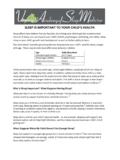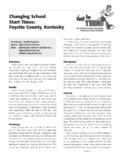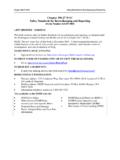Transcription of Changing School Start Times: Denver, Colorado
1 Changing School Start Times: denver , Colorado148 Schools 72,000 StudentsBefore: High School -7:30 am - 2:30 pmAfter: High School -7:30 am - 4:15 pmSummaryDenver Public Schools have adopted a change inhigh School Start times that is a bit unusual. As a resultof a change in the transportation system, denver s highschool students now have a flexible schedule and canchoose their Start and ending times. This movementwas led by their superintendent and planned andimplemented by district staff. The only major barrier wasconvincing parents of the safety of public transportation. ProfileDenver is a large urban district.
2 denver Public Schoolsruns 13 high School programs and a Career EducationCenter that together serve over 17,000 students. Denverhas always prided itself on its varied and flexible programs. The district allows each School a lot of localdiscretion in determining the internal schedule and the programs that it will offer. However, all high schoolshave always started at 7:30 am. Prior to the change, denver Public Schools provided transportation to all students who attended neighborhood schools and lived at least miles away. They also provided trans-portation to all students attending magnet schoolsacross the district, to special needs students and for allathletic programs.
3 Challenge denver initially met a lot of opposition to the idea ofmandating a later Start time . But once they had solidi-fied their proposal of switching to public transportationand a flexible schedule, the main concern in the com-munity was about the safety of the public transportationfor students. Champions The superintendent of denver Public Schools proposed that this district look at two issues: bus trans-portation and School Start times. The staff thenresearched these and developed the idea of switchingto public transportation and allowing flexibility in scheduling. While they did have opportunities forpublic comment and maintained a steady flow ofinformation, the district staff was responsible for all ofthe planning for this change.
4 Journey After the superintendent proposed that transportationand scheduling be studied, the district staff produced aninformation report. They found research on sleep andschool Start times and talked to other districts that hadmade changes in either system. The staff was convincedthat later Start times were important for high School stu-dents. But after presenting this plan they met immediateopposition from parents and students who were worriedabout extracurriculars, jobs and childcare for youngerchildren all the issues that commonly surface in thediscussion of later Start times. So the district backed offof this proposal and looked for another solution.
5 They decided to investigate the impact of switchingfrom a yellow bus system to Regional TransportationDistrict (RTD) services. The district looked at differentfactors such as ridership, ride times and distance frombus stops in both systems to determine the feasibility ofthe switch. What they found was that for many studentsride time would decrease, and the overall district aver-age was an increased ride time of only three minutes. Students were also very close to the RTD bus also determined that based on current ridership,the district could actually save money by paying for thebus passes for students to ride RTD and canceling theyellow bus runs.
6 Parents who were concerned about safety on theRTD buses were comforted by several facts. The currentcontinuedThe National Sleep FoundationAdolescent Sleep Initiativevoluntary student ridership on RTD exceeded the rider-ship of yellow buses, indicating that it was a safe andreliable mode of transportation. Principals reported veryfew problems with this transportation. RTD also has oneof the lowest crime occurrence rates in the of the high schools did surveys of their studentsabout what schedule and time frame they would results indicated that very few students wanted thechange because they were committed to their activitiesafter School .
7 But the district predicted that these num-bers would go up over the years as new studentsentered the schools who were not conditioned to thesystem of early Start times. At the February 5, 2004 School board meeting, a proposal to switch to RTD buses and to open the highschools from 7:30 am - 4:15 pm, allowing students to choose a schedule appropriate to their needs, waspresented. The issue was discussed at two subsequentmeetings, one public hearing and one with presenta-tions by the high School principals about their views onthe proposals and the results of their discussions withstudents and parents.
8 On March 18, 2004, a final reportfor action was presented to the board and adopted. SolutionDenver s 12 high schools are now open from 7:30 am-4:15 pm. While each student has a minimum numberof hours that he or she must be at School , each studentcan choose when they will Start and end their day. Thiswas possible because the students were now able toride the public buses at any time during the day. The district provides RTD passes to all students wholive more than miles from the neighborhood schoolthat they attend and to students attending magnetschools across the district. The yellow buses still run forspecial needs students, athletes and elementary andmiddle School students.
9 The district also established aset of parameters involving ride time , number of trans-fers, and the difference in ride time from the old cases where these parameters were exceeded, wherepossible, the district has provided a different transporta-tion option such as an express bus pass, or paying tohave additional buses added to certain routes. The number of classes offered at the high School at aparticular time is based on student district and RTD worked together to find a planthat would be at least cost-neutral. The final plan benefits both because RTD had higher ridership, and the district saved about $750,000 annually on the transportation budget.
10 They were able to get rid of about60 buses. Schools were flexible about athletic practices, whichwere scheduled either before or after School or duringthe last two periods of the day. Teachers were given the opportunity to choose tochange their schedules. Enough teachers were willing toshift to provide for the number of classes that new teachers were hired, and no teachers had to bepaid more. The district and RTD combined resources to provideinformation to families about the change. Question andanswer sheets were posted on both Web sites, as wellas sent home with students to their parents. ResultsThe transportation aspect of the change went few logistical problems were solved within a were very few complaints, even though thechange affected thousands of students.










